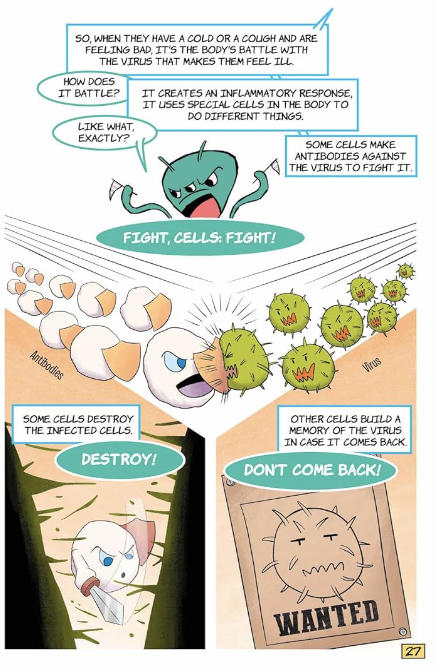The human body… more like the heroic body!
The Human Body: An Alien’s Guide, written by Ruth Redford and illustrated by Leandro Cunha, is a graphic novel about human biology. This book features two aliens, Zag and Zog, who go on an adventurous mission to learn about the human body.
I read it to my 5-year-old brother, Noah-Austin.
REVIEW
I recommend this book for kids in grades 3-4 since it is interesting, fun, and an easy read. Zag and Zog break down the human body into percentages:
 |
| “The alien has three big eyes and the other guy looks like an oval!”- Noah-Austin White
|
The aliens fly through seven systems of the body on their spaceship.
In the skeletal system, the curious aliens learn about the bones of the body, cartilage, how bones can heal themselves, and the joints' functions.

I taught Noah-Austin about his funny bone.
In the muscular system, Zag and Zog learn about the different types of muscles and their location.

“Why is an alien in the body? They should be on the moon right now!”
- Noah-Austin White
Zog talks like an alien: "That’s it? Do they ever just feel zorpy?” he says when the two learn how many muscles the face uses.
The two aliens discover the nervous system and learn about electric signals sent to the brain notifying the brain what action it needs to perform. They also discuss how nerves are needed in different places for different movements.
In the circulatory system, these cool little monsters learn about blood, blood cells, germs, blood vessels, arteries, the heart, and blood clots.

The cells mistake them for enemies and start to attack them! Luckily, the extraterrestrials escape.
In the immune system, they learn about oxygen, carbon dioxide, lungs, mucus, viruses, and, infected cells. But real trouble awaits in the digestive system.
 |
|
“The stomach mush looks like poop.”-Noah-Austin White |
In the digestive system, the one-eyed and three-eyed aliens are educated about the process of how the body digests food, the small intestine, the large intestines, feces, heartburn, stomach ache, urination, infections, and lots more! Then, the aliens start to get trapped by the stomach acid made when the human experiences heartburn, but they find a way out (phew!) without any chaos, or digestion drama in the mix.

”Why does he have so many arms?” Noah-Austin asked.
Lastly, in the endocrine system, the spacelings learn about puberty, hormones, the pituitary gland, the pineal gland, the parathyroid, the thymus gland, the pancreas, the adrenal glands, and the thyroid glands. I had no idea these were such things--I can’t even pronounce them! The octopus-like aliens also discover how emotions affect hormones.
I find this story fascinating because the facts are formatted in a way that’s easy to understand. This story differs from other biology books because it is a graphic novel and kid-friendly. I also enjoyed how in each system the aliens don’t only learn about the parts of the body, but they also have an adventure/exploration!
I recommend THE HUMAN BODY: An Alien's Guide to any kid who wants to learn about human biology. I love this book because it helped me learn a lot of important information quickly. The illustrations helped me better understand what the parts of the body look like, and the cartoony art style gave it a fun feel.
Brooke Leela-Ann White is an 11-year-old 5th grader who lives in Charlotte, North Carolina. She has written two books, “ Cupcake the Lying Unicorn” and “Cookie Cat and the Tagalongs”. When Brooke isn’t reading or writing you’ll probably spot her sewing, scootering, swimming, or studying. This is Brooke’s fourth book review, She has been dreaming about becoming a book reviewer ever since she could read!
GIVEAWAY
If you are interested in adding this book to your home or school library, leave me a comment by March 19. If you are new to my blog, make sure you leave your email address. If you are a new subscriber to my blog or an educator or librarian, I'll put your name in twice.
Don't forget to check out Greg Pattridge's great MMGM blog every Monday!












.png)












.png)
.png)
















